
Interstellar Messengers
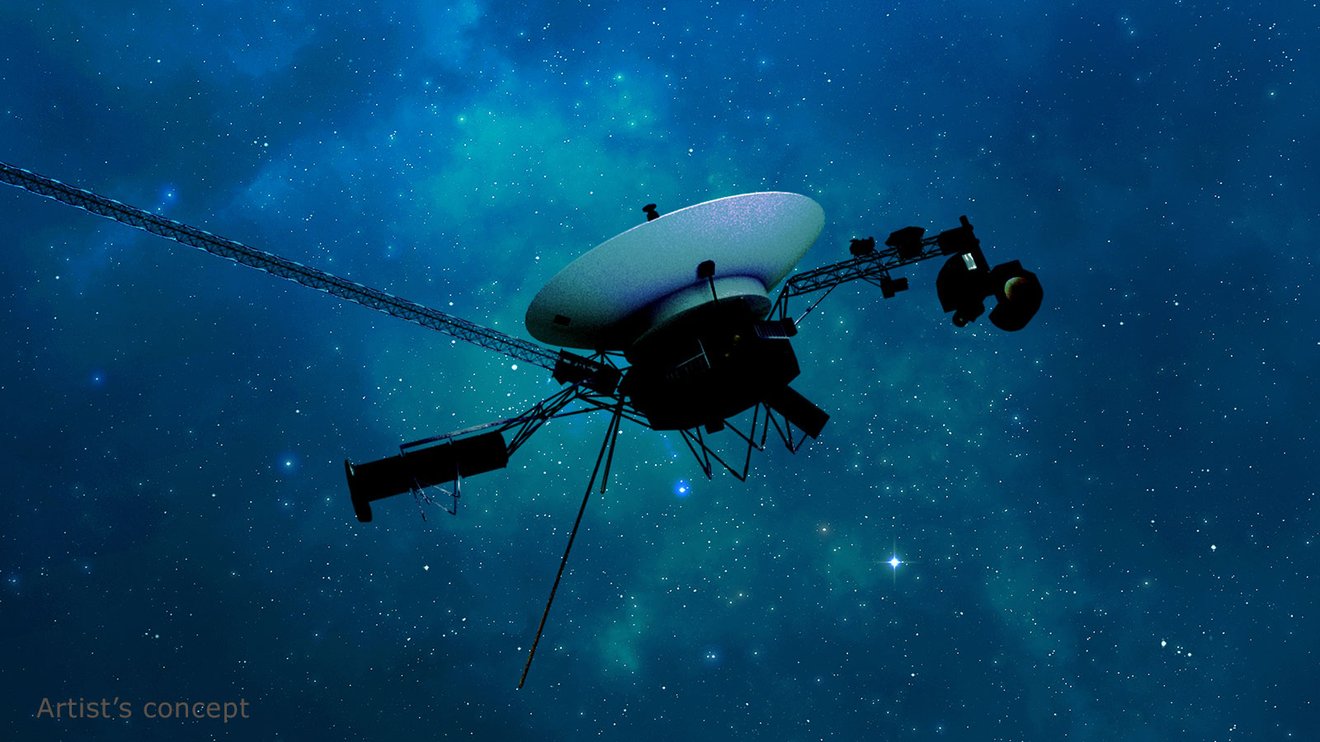
Voyager 1 and its twin Voyager 2 are the only spacecraft ever to operate outside the heliosphere, the protective bubble of particles and magnetic fields generated by the Sun. Voyager 1 reached the interstellar boundary in 2012, while Voyager 2 (traveling slower and in a different direction than its twin) reached it in 2018.
Mission Type
Science Targets

Voyager 1 & 2
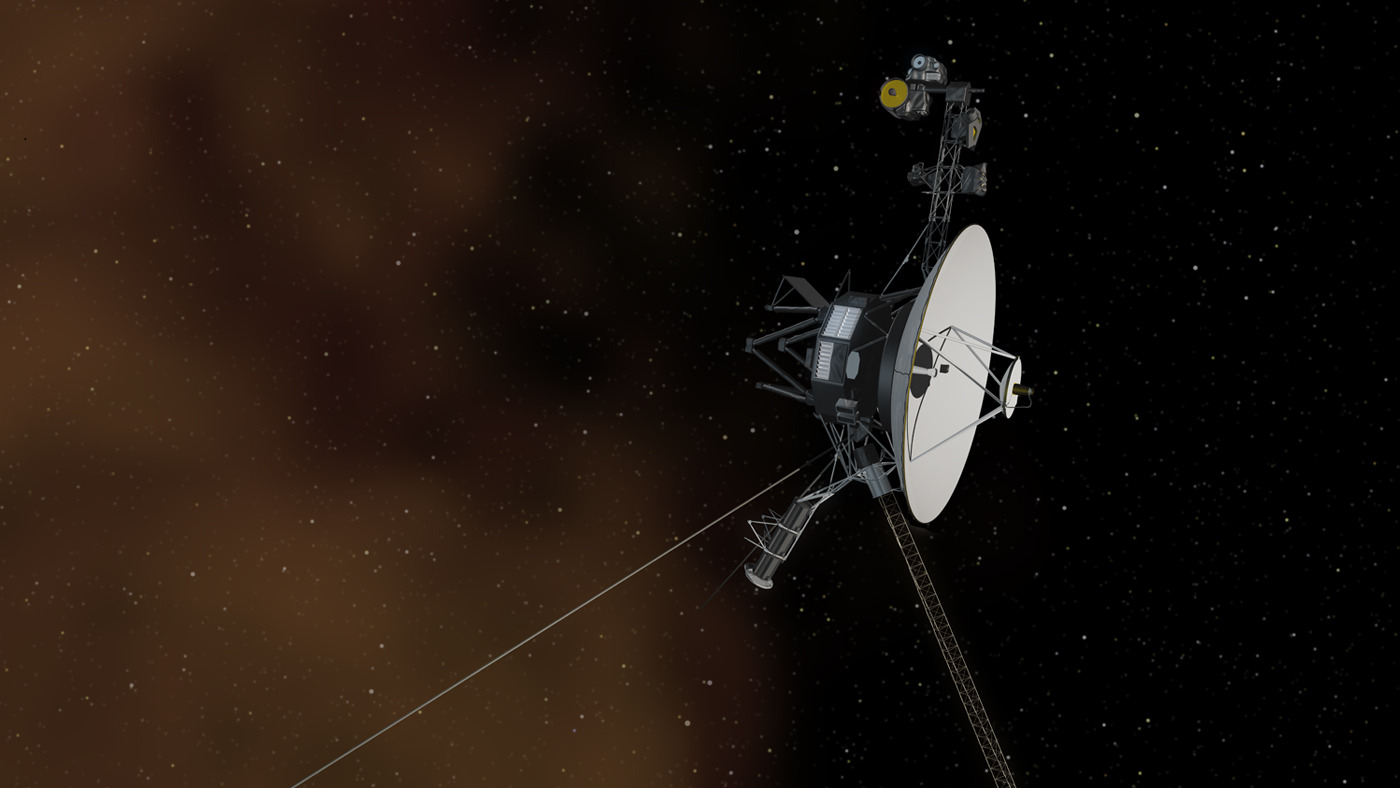
Mission Updates
Voyager 1 resumes sending engineering updates to Earth.
Latest News
NASA’s Voyager Team Focuses on Software Patch, Thrusters
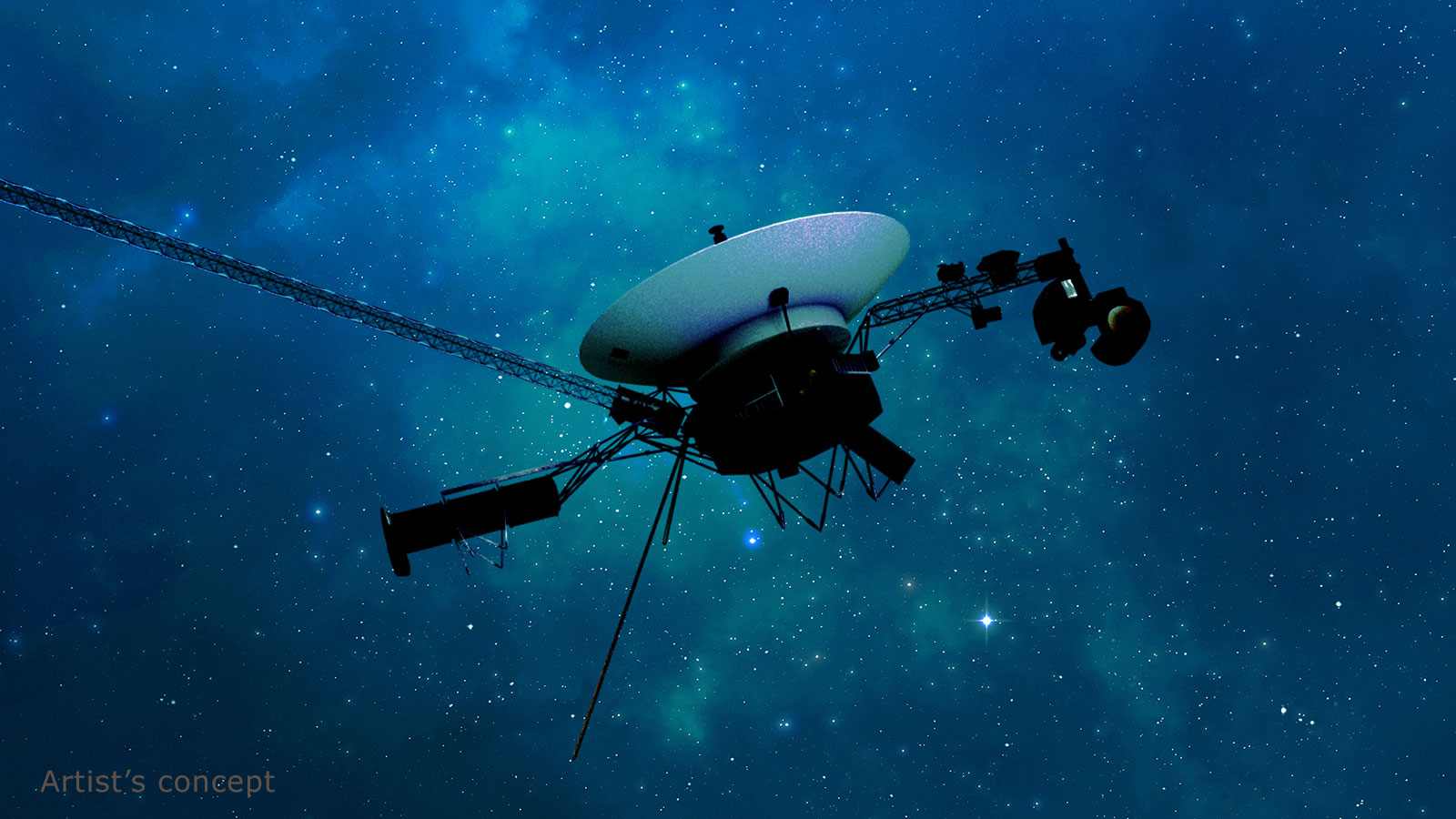
NASA’s Voyager Will Do More Science With New Power Strategy
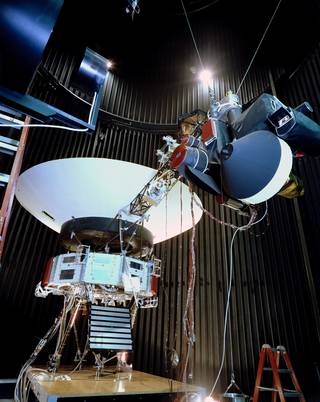
Edward Stone Retires After 50 Years as NASA Voyager’s Project Scientist
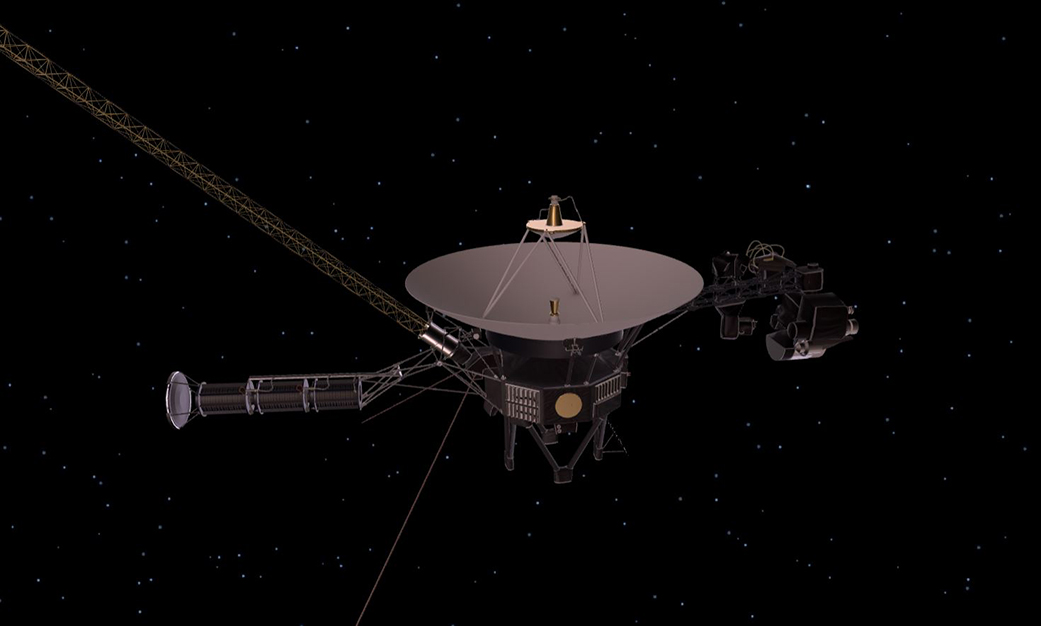
Engineers Solve Data Glitch on NASA’s Voyager 1
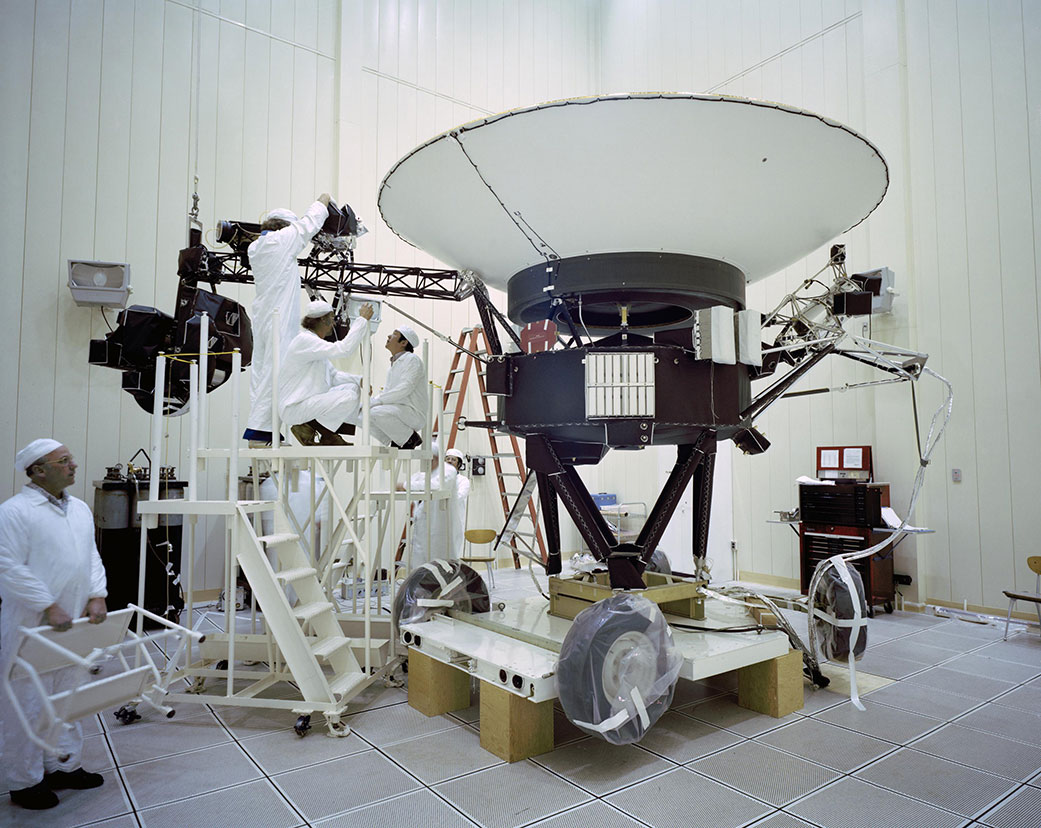
Voyager, NASA’s Longest-Lived Mission, Logs 45 Years in Space
The Interstellar Mission
After completing the first in-depth reconnaissance of the outer planets, the twin Voyagers are on a new mission to chart the edge of interstellar space.
The Golden Record
The contents of the golden record were selected for NASA by a committee led by Carl Sagan of Cornell University.
The Spacecraft
The twin Voyagers are escaping our solar system in different directions at more than 3 astronomical units (AU) a year.
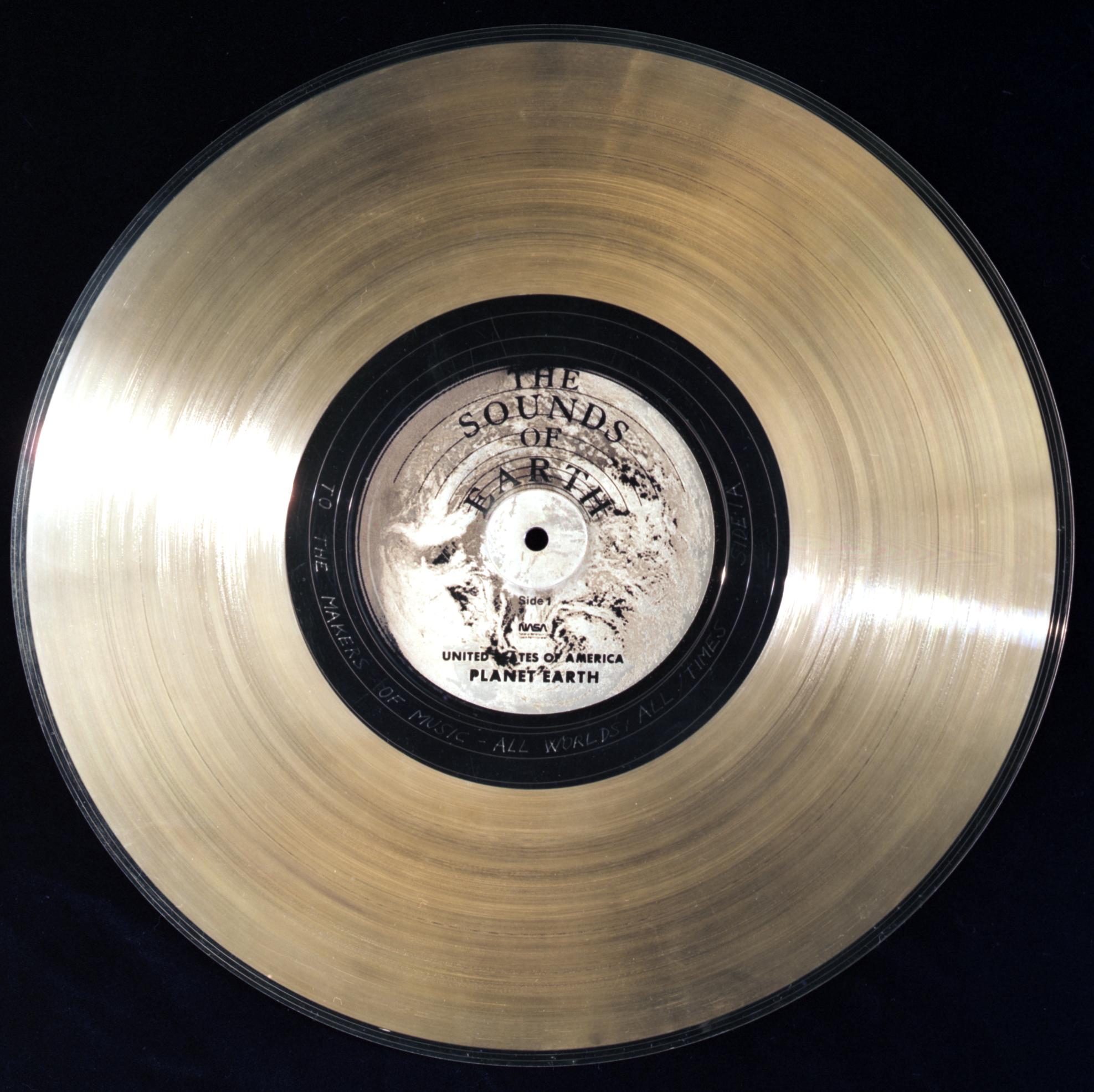
The Pale Blue Dot
The behind-the-scenes story of the making of Voyager 1's iconic image of Earth as "a mote of dust suspended in a sunbeam."
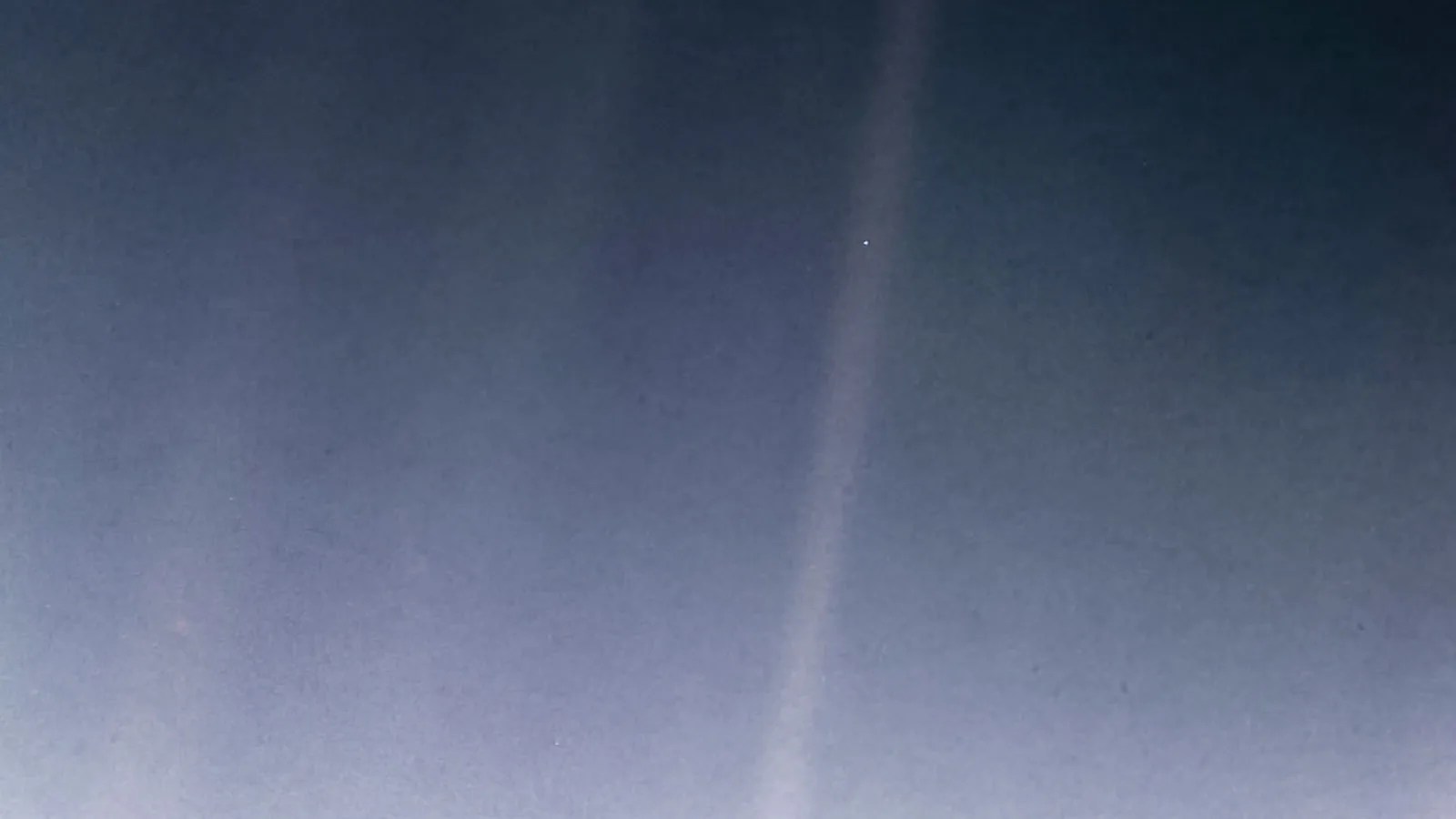
Discover More Topics From NASA

Our Solar System

Heliosphere
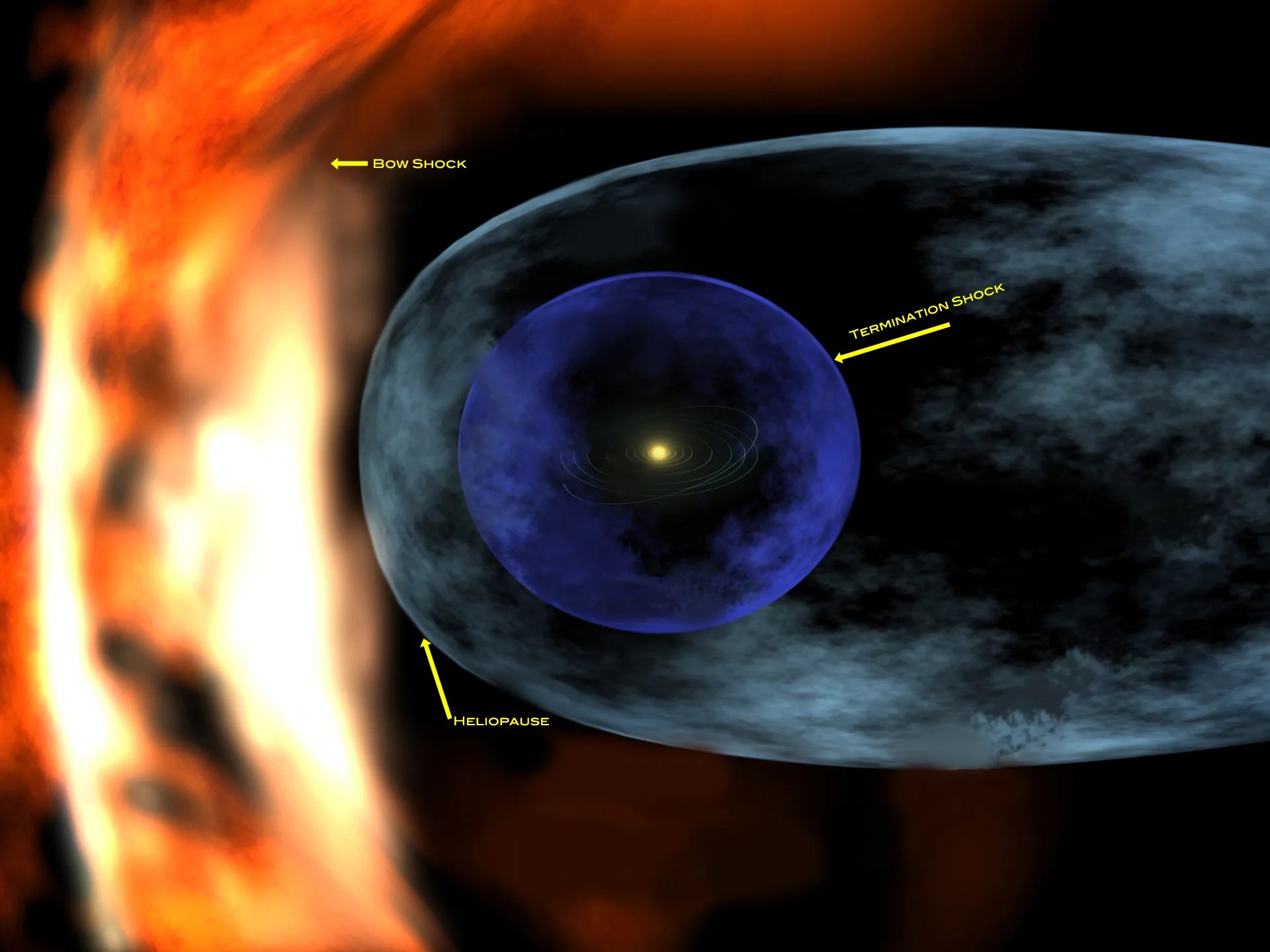

Interstellar Mission
Voyager 1 reached interstellar space in August 2012 and is the most distant human-made object in existence.

Mission Statistics
Launch Date
Sept. 5, 1977
About the mission
Voyager 1 reached interstellar space in August 2012 and is the most distant human-made object in existence. Launched just shortly after its twin spacecraft, Voyager 2, in 1977, Voyager 1 explored the Jovian and Saturnian systems discovering new moons, active volcanoes and a wealth of data about the outer solar system.
Voyagers 1 and 2 were designed to take advantage of a rare planetary alignment that occurs only once in 176 years and remain the most well traveled spacecraft in history. Both spacecraft carry a sort of time capsule called the Golden Record, a 12-inch gold-plated copper disk containing sounds and images selected to portray the story of our world to extraterrestrials.
Instruments
- Imaging system
- Infrared interferometer spectrometer
- Ultraviolet spectrometer
- Triaxial fluxgate magnetometer
- Plasma spectrometer
- Low-energy charged particles detectors
- Cosmic Ray System (CRS)
- Photopolarimeter System (PPS)
- Plasma Wave System (PWS)
Mission Highlights
Sept. 1, 2013

Interactive 3D model of Voyager 1. View the full interactive experience at Eyes on the Solar System .

Voyager 1 & 2
- Launched on September 5, 1977
- Surveyed the Jupiter and Saturn systems
- First spacecraft to reach interstellar space
- RTGs still operating
- Currently exploring beyond our solar system
- Launched on August 20, 1977
- Only spacecraft to visit Jupiter, Saturn, Uranus and Neptune
- Currently exploring the edge of the solar system
Each powered by:
- 3 Multi-Hundred Watt (MHW) RTGs stacked in a series on a boom, producing about 158 W e each, at launch.
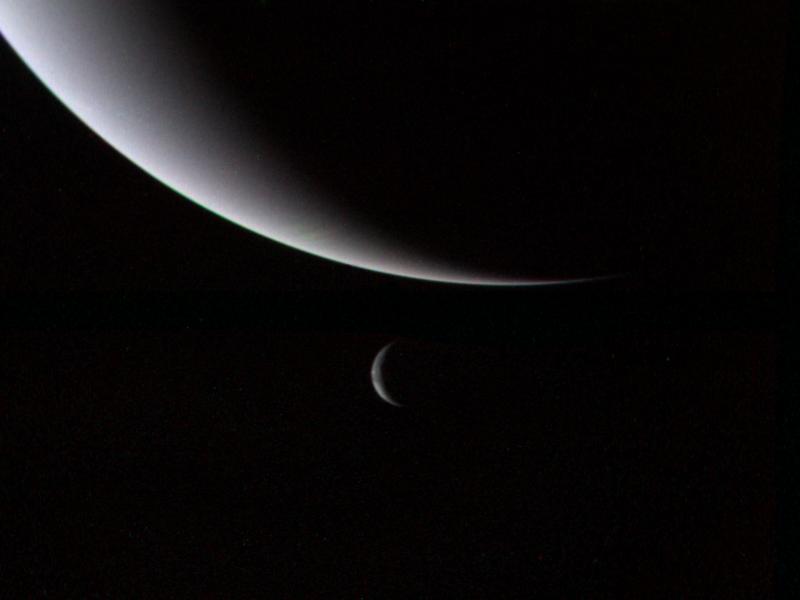
As the electrical power decreases, power loads on the spacecraft must be turned off in order to avoid having demand exceed supply. As loads are turned off, some spacecraft capabilities are eliminated.
Voyager Goals & Accomplishments
Voyager 1 and 2 were designed to take advantage of a rare planetary alignment to explore the outer solar system. Voyager 1 targeted Jupiter and Saturn before continuing on to chart the far edges of our solar system. Voyager 2 targeted Jupiter, Saturn, Uranus and Neptune before joining its sister probe on their interstellar mission.
Voyager proved to be one of the greatest missions of discovery in history. Among their many revelations about the solar system are:
- Rings around Jupiter
- Volcanoes on Jupiter's moon Io
- Moons of Saturn that shepherd its rings
- New moons around Uranus and Neptune
- Geysers of liquid nitrogen on Neptune's moon Triton
- Revealed and crossed the farthest boundary of our solar system
Voyager 2 is the only spacecraft to study all four of the solar system's giant planets at close range. The Voyagers are now exploring the outermost reaches of our sun's influence, where the solar wind mixes with the interstellar wind of our galaxy. Their long-lived power source has enabled these explorers to continue teaching us about our solar system for more than years after they left earth.
- Go to Voyager Homepage
- Go to Voyager Image Gallery
- Status: Where are the Voyagers?
Mission Elapsed Time
Inside NASA's 5-month fight to save the Voyager 1 mission in interstellar space

After working for five months to re-establish communication with the farthest-flung human-made object in existence, NASA announced this week that the Voyager 1 probe had finally phoned home.
For the engineers and scientists who work on NASA’s longest-operating mission in space, it was a moment of joy and intense relief.
“That Saturday morning, we all came in, we’re sitting around boxes of doughnuts and waiting for the data to come back from Voyager,” said Linda Spilker, the project scientist for the Voyager 1 mission at NASA’s Jet Propulsion Laboratory in Pasadena, California. “We knew exactly what time it was going to happen, and it got really quiet and everybody just sat there and they’re looking at the screen.”
When at long last the spacecraft returned the agency’s call, Spilker said the room erupted in celebration.
“There were cheers, people raising their hands,” she said. “And a sense of relief, too — that OK, after all this hard work and going from barely being able to have a signal coming from Voyager to being in communication again, that was a tremendous relief and a great feeling.”

The problem with Voyager 1 was first detected in November . At the time, NASA said it was still in contact with the spacecraft and could see that it was receiving signals from Earth. But what was being relayed back to mission controllers — including science data and information about the health of the probe and its various systems — was garbled and unreadable.
That kicked off a monthslong push to identify what had gone wrong and try to save the Voyager 1 mission.
Spilker said she and her colleagues stayed hopeful and optimistic, but the team faced enormous challenges. For one, engineers were trying to troubleshoot a spacecraft traveling in interstellar space , more than 15 billion miles away — the ultimate long-distance call.
“With Voyager 1, it takes 22 1/2 hours to get the signal up and 22 1/2 hours to get the signal back, so we’d get the commands ready, send them up, and then like two days later, you’d get the answer if it had worked or not,” Spilker said.

The team eventually determined that the issue stemmed from one of the spacecraft’s three onboard computers. Spilker said a hardware failure, perhaps as a result of age or because it was hit by radiation, likely messed up a small section of code in the memory of the computer. The glitch meant Voyager 1 was unable to send coherent updates about its health and science observations.
NASA engineers determined that they would not be able to repair the chip where the mangled software is stored. And the bad code was also too large for Voyager 1's computer to store both it and any newly uploaded instructions. Because the technology aboard Voyager 1 dates back to the 1960s and 1970s, the computer’s memory pales in comparison to any modern smartphone. Spilker said it’s roughly equivalent to the amount of memory in an electronic car key.
The team found a workaround, however: They could divide up the code into smaller parts and store them in different areas of the computer’s memory. Then, they could reprogram the section that needed fixing while ensuring that the entire system still worked cohesively.
That was a feat, because the longevity of the Voyager mission means there are no working test beds or simulators here on Earth to test the new bits of code before they are sent to the spacecraft.
“There were three different people looking through line by line of the patch of the code we were going to send up, looking for anything that they had missed,” Spilker said. “And so it was sort of an eyes-only check of the software that we sent up.”
The hard work paid off.
NASA reported the happy development Monday, writing in a post on X : “Sounding a little more like yourself, #Voyager1.” The spacecraft’s own social media account responded , saying, “Hi, it’s me.”
So far, the team has determined that Voyager 1 is healthy and operating normally. Spilker said the probe’s scientific instruments are on and appear to be working, but it will take some time for Voyager 1 to resume sending back science data.
Voyager 1 and its twin, the Voyager 2 probe, each launched in 1977 on missions to study the outer solar system. As it sped through the cosmos, Voyager 1 flew by Jupiter and Saturn, studying the planets’ moons up close and snapping images along the way.
Voyager 2, which is 12.6 billion miles away, had close encounters with Jupiter, Saturn, Uranus and Neptune and continues to operate as normal.
In 2012, Voyager 1 ventured beyond the solar system , becoming the first human-made object to enter interstellar space, or the space between stars. Voyager 2 followed suit in 2018.
Spilker, who first began working on the Voyager missions when she graduated college in 1977, said the missions could last into the 2030s. Eventually, though, the probes will run out of power or their components will simply be too old to continue operating.
Spilker said it will be tough to finally close out the missions someday, but Voyager 1 and 2 will live on as “our silent ambassadors.”
Both probes carry time capsules with them — messages on gold-plated copper disks that are collectively known as The Golden Record . The disks contain images and sounds that represent life on Earth and humanity’s culture, including snippets of music, animal sounds, laughter and recorded greetings in different languages. The idea is for the probes to carry the messages until they are possibly found by spacefarers in the distant future.
“Maybe in 40,000 years or so, they will be getting relatively close to another star,” Spilker said, “and they could be found at that point.”
Denise Chow is a reporter for NBC News Science focused on general science and climate change.

Suggested Searches
- Climate Change
- Expedition 64
- Mars perseverance
- SpaceX Crew-2
- International Space Station
- View All Topics A-Z
Humans in Space
Earth & climate, the solar system, the universe, aeronautics, learning resources, news & events.

NASA-Led Study Provides New Global Accounting of Earth’s Rivers

NASA’s Hubble Pauses Science Due to Gyro Issue

NASA’s Optical Comms Demo Transmits Data Over 140 Million Miles
- Search All NASA Missions
- A to Z List of Missions
- Upcoming Launches and Landings
- Spaceships and Rockets
- Communicating with Missions
- James Webb Space Telescope
- Hubble Space Telescope
- Why Go to Space
- Astronauts Home
- Commercial Space
- Destinations
- Living in Space
- Explore Earth Science
- Earth, Our Planet
- Earth Science in Action
- Earth Multimedia
- Earth Science Researchers
- Pluto & Dwarf Planets
- Asteroids, Comets & Meteors
- The Kuiper Belt
- The Oort Cloud
- Skywatching
- The Search for Life in the Universe
- Black Holes
- The Big Bang
- Dark Energy & Dark Matter
- Earth Science
- Planetary Science
- Astrophysics & Space Science
- The Sun & Heliophysics
- Biological & Physical Sciences
- Lunar Science
- Citizen Science
- Astromaterials
- Aeronautics Research
- Human Space Travel Research
- Science in the Air
- NASA Aircraft
- Flight Innovation
- Supersonic Flight
- Air Traffic Solutions
- Green Aviation Tech
- Drones & You
- Technology Transfer & Spinoffs
- Space Travel Technology
- Technology Living in Space
- Manufacturing and Materials
- Science Instruments
- For Kids and Students
- For Educators
- For Colleges and Universities
- For Professionals
- Science for Everyone
- Requests for Exhibits, Artifacts, or Speakers
- STEM Engagement at NASA
- NASA's Impacts
- Centers and Facilities
- Directorates
- Organizations
- People of NASA
- Internships
- Our History
- Doing Business with NASA
- Get Involved
- Aeronáutica
- Ciencias Terrestres
- Sistema Solar
- All NASA News
- Video Series on NASA+
- Newsletters
- Social Media
- Media Resources
- Upcoming Launches & Landings
- Virtual Events
- Sounds and Ringtones
- Interactives
- STEM Multimedia

Correction and Clarification of C.26 Rapid Mission Design Studies for Mars Sample Return

NASA’s Commercial Partners Deliver Cargo, Crew for Station Science

NASA Shares Lessons of Human Systems Integration with Industry

Work Underway on Large Cargo Landers for NASA’s Artemis Moon Missions

NASA’s ORCA, AirHARP Projects Paved Way for PACE to Reach Space

Amendment 11: Physical Oceanography not solicited in ROSES-2024

Why is Methane Seeping on Mars? NASA Scientists Have New Ideas

Mars Science Laboratory: Curiosity Rover

Hubble Spots a Magnificent Barred Galaxy

NASA’s Chandra Releases Doubleheader of Blockbuster Hits

Explore the Universe with the First E-Book from NASA’s Fermi

NASA Grant Brings Students at Underserved Institutions to the Stars

NASA Photographer Honored for Thrilling Inverted In-Flight Image

NASA’s Ingenuity Mars Helicopter Team Says Goodbye … for Now

NASA Langley Team to Study Weather During Eclipse Using Uncrewed Vehicles

NASA Data Helps Beavers Build Back Streams

NASA’s Near Space Network Enables PACE Climate Mission to ‘Phone Home’

Washington State High Schooler Wins 2024 NASA Student Art Contest

NASA STEM Artemis Moon Trees

Kiyun Kim: From Intern to Accessibility Advocate

Diez maneras en que los estudiantes pueden prepararse para ser astronautas

Astronauta de la NASA Marcos Berríos

Resultados científicos revolucionarios en la estación espacial de 2023
Voyager 1 & 2.

The primary mission of Voyager 1 and 2 was the exploration of Jupiter and Saturn; after completing this objective, Voyager 1 and 2’s missions were extended. The Voyager Interstellar Mission will explore the limits of the Sun’s influence at the edge of the solar system and beyond. Penetration of the heliopause boundary between the solar wind and the interstellar medium will allow measurements to be made of the interstellar fields, particles, and waves unaffected by the solar wind.
Launch : August/September 1977 Operating Network : Deep Space Network
› Deep Space Network (DSN) › Voyager 1 & 2 › Universe Missions Supported by SCaN

- The Contents
- The Making of
- Where Are They Now
- Frequently Asked Questions
- Q & A with Ed Stone
golden record
Where are they now.
- frequently asked questions
- Q&A with Ed Stone
Galleries of Images Voyager Took
The Voyager 1 and 2 spacecraft explored Jupiter, Saturn, Uranus and Neptune before starting their journey toward interstellar space. Here you'll find some of those iconic images, including "The Pale Blue Dot" - famously described by Carl Sagan - and what are still the only up-close images of Uranus and Neptune.
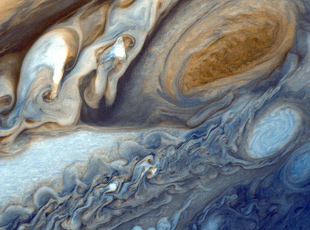
Photography of Jupiter began in January 1979, when images of the brightly banded planet already exceeded the best taken from Earth. Voyager 1 completed its Jupiter encounter in early April, after taking almost 19,000 pictures and many other scientific measurements. Voyager 2 picked up the baton in late April and its encounter continued into August. They took more than 33,000 pictures of Jupiter and its five major satellites.
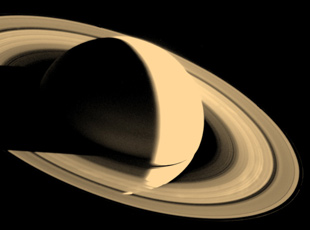
The Voyager 1 and 2 Saturn encounters occurred nine months apart, in November 1980 and August 1981. Voyager 1 is leaving the solar system. Voyager 2 completed its encounter with Uranus in January 1986 and with Neptune in August 1989, and is now also en route out of the solar system.
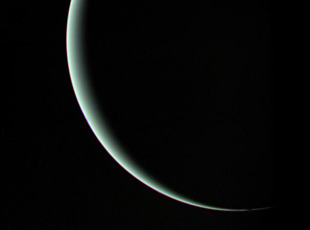
NASA's Voyager 2 spacecraft flew closely past distant Uranus, the seventh planet from the Sun, in January. At its closet, the spacecraft came within 81,800 kilometers (50,600 miles) of Uranus's cloudtops on Jan. 24, 1986. Voyager 2 radioed thousands of images and voluminous amounts of other scientific data on the planet, its moons, rings, atmosphere, interior and the magnetic environment surrounding Uranus.
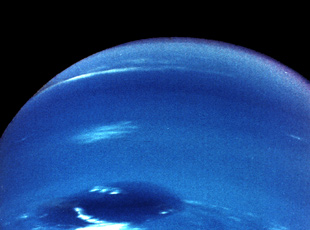
In the summer of 1989, NASA's Voyager 2 became the first spacecraft to observe the planet Neptune, its final planetary target. Passing about 4,950 kilometers (3,000 miles) above Neptune's north pole, Voyager 2 made its closest approach to any planet since leaving Earth 12 years ago. Five hours later, Voyager 2 passed about 40,000 kilometers (25,000 miles) from Neptune's largest moon, Triton, the last solid body the spacecraft will have an opportunity to study.
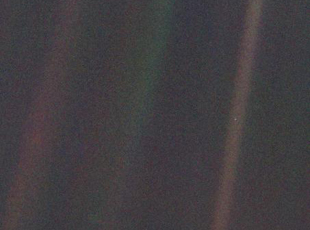
This narrow-angle color image of the Earth, dubbed 'Pale Blue Dot', is a part of the first ever 'portrait' of the solar system taken by Voyager 1. The spacecraft acquired a total of 60 frames for a mosaic of the solar system from a distance of more than 4 billion miles from Earth and about 32 degrees above the ecliptic. From Voyager's great distance Earth is a mere point of light, less than the size of a picture element even in the narrow-angle camera. Earth was a crescent only 0.12 pixel in size. Coincidentally, Earth lies right in the center of one of the scattered light rays resulting from taking the image so close to the sun. This blown-up image of the Earth was taken through three color filters -- violet, blue and green -- and recombined to produce the color image. The background features in the image are artifacts resulting from the magnification.
- Mobile Site
- Staff Directory
- Advertise with Ars
Filter by topic
- Biz & IT
- Gaming & Culture
Front page layout
22.5 light hours —
Recoding voyager 1—nasa’s interstellar explorer is finally making sense again, "we're pretty much seeing everything we had hoped for, and that's always good news.”.
Stephen Clark - Apr 23, 2024 5:56 pm UTC
Engineers have partially restored a 1970s-era computer on NASA's Voyager 1 spacecraft after five months of long-distance troubleshooting, building confidence that humanity's first interstellar probe can eventually resume normal operations.
Several dozen scientists and engineers gathered Saturday in a conference room at NASA's Jet Propulsion Laboratory, or connected virtually, to wait for a new signal from Voyager 1. The ground team sent a command up to Voyager 1 on Thursday to recode part of the memory of the spacecraft's Flight Data Subsystem (FDS) , one of the probe's three computers.
“In the minutes leading up to when we were going to see a signal, you could have heard a pin drop in the room," said Linda Spilker, project scientist for NASA's two Voyager spacecraft at JPL. "It was quiet. People were looking very serious. They were looking at their computer screens. Each of the subsystem (engineers) had pages up that they were looking at, to watch as they would be populated."
Finally, a breakthrough
Launched nearly 47 years ago, Voyager 1 is flying on an outbound trajectory more than 15 billion miles (24 billion kilometers) from Earth, and it takes 22-and-a-half hours for a radio signal to cover that distance at the speed of light. This means it takes nearly two days for engineers to uplink a command to Voyager 1 and get a response.
In November, Voyager 1 suddenly stopped transmitting its usual stream of data containing information about the spacecraft's health and measurements from its scientific instruments. Instead, the spacecraft's data stream was entirely unintelligible. Because the telemetry was unreadable, experts on the ground could not easily tell what went wrong. They hypothesized the source of the problem might be in the memory bank of the FDS.
There was a breakthrough last month when engineers sent up a novel command to "poke" Voyager 1's FDS to send back a readout of its memory. This readout allowed engineers to pinpoint the location of the problem in the FDS memory . The FDS is responsible for packaging engineering and scientific data for transmission to Earth.
After a few weeks, NASA was ready to uplink a solution to get the FDS to resume packing engineering data. This data stream includes information on the status of the spacecraft—things like power levels and temperature measurements. This command went up to Voyager 1 through one of NASA's large Deep Space Network antennas Thursday.
Then, the wait for a response. Spilker, who started working on Voyager right out of college in 1977, was in the room when Voyager 1's signal reached Earth Saturday.
"When the time came to get the signal, we could clearly see all of a sudden, boom, we had data, and there were tears and smiles and high fives," she told Ars. "Everyone was very happy and very excited to see that, hey, we're back in communication again with Voyager 1. We're going to see the status of the spacecraft, the health of the spacecraft, for the first time in five months."

Throughout the five months of troubleshooting, Voyager's ground team continued to receive signals indicating the spacecraft was still alive. But until Saturday, they lacked insight into specific details about the status of Voyager 1.
“It’s pretty much just the way we left it," Spilker said. "We're still in the initial phases of analyzing all of the channels and looking at their trends. Some of the temperatures went down a little bit with this period of time that's gone on, but we're pretty much seeing everything we had hoped for. And that's always good news.”
Relocating code
Through their investigation, Voyager's ground team discovered a single chip responsible for storing a portion of the FDS memory stopped working, probably due to either a cosmic ray hit or a failure of aging hardware. This affected some of the computer's software code.
"That took out a section of memory," Spilker said. "What they have to do is relocate that code into a different portion of the memory, and then make sure that anything that uses those codes, those subroutines, know to go to the new location of memory, for access and to run it."
Only about 3 percent of the FDS memory was corrupted by the bad chip, so engineers needed to transplant that code into another part of the memory bank. But no single location is large enough to hold the section of code in its entirety, NASA said.
So the Voyager team divided the code into sections for storage in different places in the FDS. This wasn't just a copy-and-paste job. Engineers needed to modify some of the code to make sure it will all work together. "Any references to the location of that code in other parts of the FDS memory needed to be updated as well," NASA said in a statement.
reader comments
Channel ars technica.

Voyager 1 y 2: La Misión Interestelar
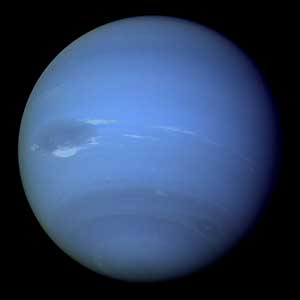
Imagen de Neptuno tomada por la nave espacial Voyager 2. Imagen crédito: NASA
NASA tiene hermosas fotos de cada planeta de nuestro sistema solar. Incluso tenemos imágenes del lejano Neptuno , como podemos apreciar en la foto de arriba.
Neptuno está demasiado lejos para que un astronauta viaje hasta allí con una cámara. Entonces, ¿cómo tenemos imágenes de lugares tan lejanos de nuestro sistema solar? Nuestros fotógrafos fueron dos naves espaciales llamadas ¡Voyager 1 y Voyager 2!
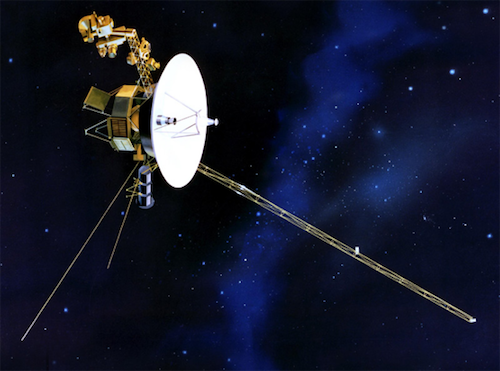
Representación artística de una de las naves espaciales Voyager. Imagen crédito: NASA
Las naves espaciales Voyager 1 y Voyager 2 fueron lanzadas desde la Tierra en 1977. Su misión fue explorar Júpiter y Saturno --y planetas que se encuentran más allá de nuestro sistema solar. Esta fue una gran hazaña. Ningún objeto hecho en el pasado por el ser humano, había intentado un viaje como éste.
Las dos naves espaciales tomaron decenas de miles de imágenes de Júpiter y Saturno. Las imágenes del Voyager 1 y 2 nos permitieron ver muchas cosas por primera vez. Por ejemplo, ellos capturaron fotos a detalle de las nubes y tormentas de Júpiter, y la estructura de los anillos de Saturno .
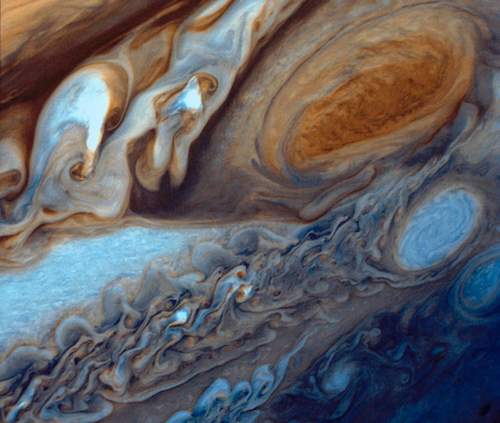
Imagen de las tormentas en Júpiter tomadas por la nave espacial Voyager 1. Crédito: NASA
Voyager 1 y 2 también descubrieron volcanes activos en Io, una de las lunas de Júpiter , y mucho más. Voyager 2 también tomó imágenes de Urano y Neptuno. En conjunto, la misión Voyager descubrió 22 lunas.
Desde entonces, estas astronaves continúan su viaje alejándose de nosotros. Voyager 1 y 2 están ahora tan lejos que han llegado al espacio interestelar --la región entre las estrellas. Ninguna otra nave espacial ha viajado tan lejos.

¿A dónde irá Voyager después?
¡Mira éste video para descubrir qué hay más allá de nuestro sistema solar!
Ambas naves espaciales continúan enviando información de regreso a la Tierra. Estos datos nos ayudarán a entender acerca de las condiciones en el distante sistema solar y el espacio interestelar.
Los Voyager tienen suficiente combustible y energía para operar hasta el 2025 y más allá. Después de algún tiempo de esto, ya no podrán comunicarse con la Tierra. A menos que algo los detenga, continuarán pasando por nuevas estrellas una y otra vez por muchos miles de años.
Cada nave espacial Voyager contiene un mensaje. Ambas lleva consigo un disco de oro con escenas y sonidos de la Tierra. Los discos también contienen música y saludos en diferentes idiomas. Por lo cual, si vida inteligente encuentra alguna vez estas naves espaciales, ¡podrán saber acerca de la Tierra y de nosotros!
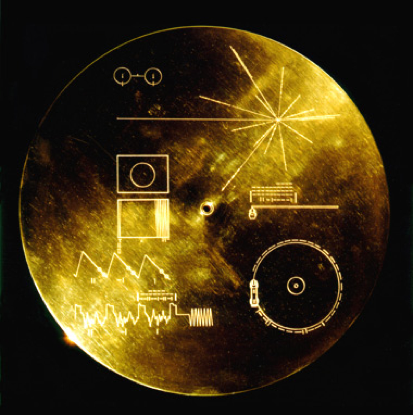
Foto del disco de oro que se envió al espacio en ambos Voyagers 1 y 2. Imagen crédito: NASA/JPL-Caltech
¡Más sobre nuestro universo!

¿Dónde comienza el espacio interestelar?

Buscando otros planetas como el nuestro.

¡Juega al Explorador Galáctico!
More about our universe!

Where does interstellar space begin?

Searching for other planets like ours

Play Galactic Explorer!
- Skip to main content
- Keyboard shortcuts for audio player
Well, hello, Voyager 1! The venerable spacecraft is once again making sense

Nell Greenfieldboyce

Members of the Voyager team celebrate at NASA's Jet Propulsion Laboratory after receiving data about the health and status of Voyager 1 for the first time in months. NASA/JPL-Caltech hide caption
Members of the Voyager team celebrate at NASA's Jet Propulsion Laboratory after receiving data about the health and status of Voyager 1 for the first time in months.
NASA says it is once again able to get meaningful information back from the Voyager 1 probe, after months of troubleshooting a glitch that had this venerable spacecraft sending home messages that made no sense.
The Voyager 1 and Voyager 2 probes launched in 1977 on a mission to study Jupiter and Saturn but continued onward through the outer reaches of the solar system. In 2012, Voyager 1 became the first spacecraft to enter interstellar space, the previously unexplored region between the stars. (Its twin, traveling in a different direction, followed suit six years later.)
Voyager 1 had been faithfully sending back readings about this mysterious new environment for years — until November, when its messages suddenly became incoherent .

NASA's Voyager 1 spacecraft is talking nonsense. Its friends on Earth are worried
It was a serious problem that had longtime Voyager scientists worried that this historic space mission wouldn't be able to recover. They'd hoped to be able to get precious readings from the spacecraft for at least a few more years, until its power ran out and its very last science instrument quit working.
For the last five months, a small team at NASA's Jet Propulsion Laboratory in California has been working to fix it. The team finally pinpointed the problem to a memory chip and figured out how to restore some essential software code.
"When the mission flight team heard back from the spacecraft on April 20, they saw that the modification worked: For the first time in five months, they have been able to check the health and status of the spacecraft," NASA stated in an update.
The usable data being returned so far concerns the workings of the spacecraft's engineering systems. In the coming weeks, the team will do more of this software repair work so that Voyager 1 will also be able to send science data, letting researchers once again see what the probe encounters as it journeys through interstellar space.

After a 12.3 billion-mile 'shout,' NASA regains full contact with Voyager 2
- interstellar mission
Voyager 1 had a problem. Here's how NASA fixed it from 15 billion miles away.
Working from more than 15 billion miles away, NASA engineers have solved a computer problem aboard Voyager 1 , allowing the probe to send readable data five months after a chip error made its transmissions impossible to decipher.
Voyager 1, along with its sister craft, Voyager 2, are robotic probes that were launched in 1977. Voyager 1 reached interstellar space in 2012. It's now 15.1 billion miles away, the farthest from Earth a human-made object has ever traveled.
Learn more: Closer look at Voyager 1 and Voyager 2 .
Voyager 2 entered interstellar space − the space between the stars, starting at abou t 11 billion miles from our sun − in 2018. It's now 12.7 billion miles away.
Voyager 1's computer glitch garbled the science and engineering data the craft sends to Earth, which rendered it unreadable. That started on Nov. 14, 2023.
How did engineers fix Voyager's problem?
Engineers from NASA and the Jet Propulsion Laboratory discovered a single computer chip inside the spacecraft’s Flight Data Subsystem – which collects science and engineering information and transmits it to Earth – had malfunctioned.
Can't see our graphics? Click here .
The chip stored part of the Flight Data Subsystem's memory and software code. Engineers could still receive data from Voyager 1, but it was scrambled.
The chip could not be repaired. Instead, engineers moved software code from the chip into a different part of the subsystem's memory system.
The code was too large to to be stored in a single location in the spacecraft. Engineers divided the code into sections and stored them in different places within the subsystem. The code sections were adjusted to make sure they worked as a whole.
Engineers tested the fix by moving a code that transmits data about the spacecraft. They were rewarded with a transmission from Voyager that contained readable data about the craft's status.
All that took time. Voyager is moving about 38,000 mph. Because it's so far away, it takes 22.5 hours for a radio signal to reach Voyager. It takes another 22.5 hours for the spacecraft’s reply to reach antenna networks on Earth.
What happens next?
Engineers will reposition and synchronize the other parts of the code. That should allow Voyager 1 to start sending readable data on what it finds as it moves farther away from Earth.
SOURCE USA TODAY Network reporting and research; NASA/Jet Propulsion Laboratory/California Institute of Technology; Reuters
NASA's Voyager 1 spacecraft finally phones home after 5 months of no contact
On Saturday, April 5, Voyager 1 finally "phoned home" and updated its NASA operating team about its health.

NASA's interstellar explorer Voyager 1 is finally communicating with ground control in an understandable way again. On Saturday (April 20), Voyager 1 updated ground control about its health status for the first time in 5 months. While the Voyager 1 spacecraft still isn't sending valid science data back to Earth, it is now returning usable information about the health and operating status of its onboard engineering systems.
Thirty-five years after its launch in 1977, Voyager 1 became the first human-made object to leave the solar system and enter interstellar space . It was followed out of our cosmic quarters by its space-faring sibling, Voyager 2 , six years later in 2018. Voyager 2, thankfully, is still operational and communicating well with Earth.
The two spacecraft remain the only human-made objects exploring space beyond the influence of the sun. However, on Nov. 14, 2023, after 11 years of exploring interstellar space and while sitting a staggering 15 billion miles (24 billion kilometers) from Earth, Voyager 1's binary code — computer language composed of 0s and 1s that it uses to communicate with its flight team at NASA — stopped making sense.
Related: We finally know why NASA's Voyager 1 spacecraft stopped communicating — scientists are working on a fix
In March, NASA's Voyager 1 operating team sent a digital "poke" to the spacecraft, prompting its flight data subsystem (FDS) to send a full memory readout back home.
This memory dump revealed to scientists and engineers that the "glitch" is the result of a corrupted code contained on a single chip representing around 3% of the FDS memory. The loss of this code rendered Voyager 1's science and engineering data unusable.

The NASA team can't physically repair or replace this chip, of course, but what they can do is remotely place the affected code elsewhere in the FDS memory. Though no single section of the memory is large enough to hold this code entirely, the team can slice it into sections and store these chunks separately. To do this, they will also have to adjust the relevant storage sections to ensure the addition of this corrupted code won't cause those areas to stop operating individually, or working together as a whole. In addition to this, NASA staff will also have to ensure any references to the corrupted code's location are updated.
Get the Space.com Newsletter
Breaking space news, the latest updates on rocket launches, skywatching events and more!
— Voyager 2: An iconic spacecraft that's still exploring 45 years on
— NASA's interstellar Voyager probes get software updates beamed from 12 billion miles away
— NASA Voyager 2 spacecraft extends its interstellar science mission for 3 more years
On April 18, 2024, the team began sending the code to its new location in the FDS memory. This was a painstaking process, as a radio signal takes 22.5 hours to traverse the distance between Earth and Voyager 1, and it then takes another 22.5 hours to get a signal back from the craft.
By Saturday (April 20), however, the team confirmed their modification had worked. For the first time in five months, the scientists were able to communicate with Voyager 1 and check its health. Over the next few weeks, the team will work on adjusting the rest of the FDS software and aim to recover the regions of the system that are responsible for packaging and returning vital science data from beyond the limits of the solar system.
Join our Space Forums to keep talking space on the latest missions, night sky and more! And if you have a news tip, correction or comment, let us know at: [email protected].

Robert Lea is a science journalist in the U.K. whose articles have been published in Physics World, New Scientist, Astronomy Magazine, All About Space, Newsweek and ZME Science. He also writes about science communication for Elsevier and the European Journal of Physics. Rob holds a bachelor of science degree in physics and astronomy from the U.K.’s Open University. Follow him on Twitter @sciencef1rst.
SpaceX launching Falcon 9 rocket on record-tying 20th mission today
Boeing Starliner 1st astronaut flight: Live updates
Russia vetoes UN resolution against nuclear weapons in space
Most Popular
- 2 Beavers are helping fight climate change, satellite data shows
- 3 Astronomers just discovered a comet that could be brighter than most stars when we see it next year. Or will it?
- 4 This Week In Space podcast: Episode 108 — Starliner: Better Late Than Never?
- 5 Boeing's Starliner spacecraft will not fly private missions yet, officials say
- International edition
- Australia edition
- Europe edition

Voyager 1 transmitting data again after Nasa remotely fixes 46-year-old probe
Engineers spent months working to repair link with Earth’s most distant spacecraft, says space agency
Earth’s most distant spacecraft, Voyager 1, has started communicating properly again with Nasa after engineers worked for months to remotely fix the 46-year-old probe.
Nasa’s Jet Propulsion Laboratory (JPL), which makes and operates the agency’s robotic spacecraft, said in December that the probe – more than 15bn miles (24bn kilometres) away – was sending gibberish code back to Earth.
In an update released on Monday , JPL announced the mission team had managed “after some inventive sleuthing” to receive usable data about the health and status of Voyager 1’s engineering systems. “The next step is to enable the spacecraft to begin returning science data again,” JPL said. Despite the fault, Voyager 1 had operated normally throughout, it added.
Launched in 1977, Voyager 1 was designed with the primary goal of conducting close-up studies of Jupiter and Saturn in a five-year mission. However, its journey continued and the spacecraft is now approaching a half-century in operation.
Voyager 1 crossed into interstellar space in August 2012, making it the first human-made object to venture out of the solar system. It is currently travelling at 37,800mph (60,821km/h).
Hi, it's me. - V1 https://t.co/jgGFBfxIOe — NASA Voyager (@NASAVoyager) April 22, 2024
The recent problem was related to one of the spacecraft’s three onboard computers, which are responsible for packaging the science and engineering data before it is sent to Earth. Unable to repair a broken chip, the JPL team decided to move the corrupted code elsewhere, a tricky job considering the old technology.
The computers on Voyager 1 and its sister probe, Voyager 2, have less than 70 kilobytes of memory in total – the equivalent of a low-resolution computer image. They use old-fashioned digital tape to record data.
The fix was transmitted from Earth on 18 April but it took two days to assess if it had been successful as a radio signal takes about 22 and a half hours to reach Voyager 1 and another 22 and a half hours for a response to come back to Earth. “When the mission flight team heard back from the spacecraft on 20 April, they saw that the modification worked,” JPL said.
Alongside its announcement, JPL posted a photo of members of the Voyager flight team cheering and clapping in a conference room after receiving usable data again, with laptops, notebooks and doughnuts on the table in front of them.
The Retired Canadian astronaut Chris Hadfield, who flew two space shuttle missions and acted as commander of the International Space Station, compared the JPL mission to long-distance maintenance on a vintage car.
“Imagine a computer chip fails in your 1977 vehicle. Now imagine it’s in interstellar space, 15bn miles away,” Hadfield wrote on X . “Nasa’s Voyager probe just got fixed by this team of brilliant software mechanics.
Voyager 1 and 2 have made numerous scientific discoveries , including taking detailed recordings of Saturn and revealing that Jupiter also has rings, as well as active volcanism on one of its moons, Io. The probes later discovered 23 new moons around the outer planets.
As their trajectory takes them so far from the sun, the Voyager probes are unable to use solar panels, instead converting the heat produced from the natural radioactive decay of plutonium into electricity to power the spacecraft’s systems.
Nasa hopes to continue to collect data from the two Voyager spacecraft for several more years but engineers expect the probes will be too far out of range to communicate in about a decade, depending on how much power they can generate. Voyager 2 is slightly behind its twin and is moving slightly slower.
In roughly 40,000 years, the probes will pass relatively close, in astronomical terms, to two stars. Voyager 1 will come within 1.7 light years of a star in the constellation Ursa Minor, while Voyager 2 will come within a similar distance of a star called Ross 248 in the constellation of Andromeda.

Cosmic cleaners: the scientists scouring English cathedral roofs for space dust

Russia acknowledges continuing air leak from its segment of space station

Uncontrolled European satellite falls to Earth after 30 years in orbit

Cosmonaut Oleg Kononenko sets world record for most time spent in space

‘Old smokers’: astronomers discover giant ancient stars in Milky Way

Nasa postpones plans to send humans to moon

What happened to the Peregrine lander and what does it mean for moon missions?

Peregrine 1 has ‘no chance’ of landing on moon due to fuel leak
Most viewed.
- Election 2024
- Entertainment
- Newsletters
- Photography
- Personal Finance
- AP Investigations
- AP Buyline Personal Finance
- AP Buyline Shopping
- Press Releases
- Israel-Hamas War
- Russia-Ukraine War
- Global elections
- Asia Pacific
- Latin America
- Middle East
- Election Results
- Delegate Tracker
- AP & Elections
- Auto Racing
- 2024 Paris Olympic Games
- Movie reviews
- Book reviews
- Personal finance
- Financial Markets
- Business Highlights
- Financial wellness
- Artificial Intelligence
- Social Media
NASA hears from Voyager 1, the most distant spacecraft from Earth, after months of quiet
This illustration provided by NASA depicts Voyager 1. The most distant spacecraft from Earth stopped sending back understandable data in November 2023. Flight controllers traced the blank communication to a bad computer chip and rearranged the spacecraft’s coding to work around the trouble. In mid-April 2024, NASA’s Jet Propulsion Laboratory declared success after receiving good engineering updates. The team is still working to restore transmission of the science data. (NASA via AP)
- Copy Link copied
CAPE CANAVERAL, Fla. (AP) — NASA has finally heard back from Voyager 1 again in a way that makes sense.
The most distant spacecraft from Earth stopped sending back understandable data last November. Flight controllers traced the blank communication to a bad computer chip and rearranged the spacecraft’s coding to work around the trouble.
NASA’s Jet Propulsion Laboratory in Southern California declared success after receiving good engineering updates late last week. The team is still working to restore transmission of the science data.
It takes 22 1/2 hours to send a signal to Voyager 1, more than 15 billion miles (24 billion kilometers) away in interstellar space. The signal travel time is double that for a round trip.
Contact was never lost, rather it was like making a phone call where you can’t hear the person on the other end, a JPL spokeswoman said Tuesday.
Launched in 1977 to study Jupiter and Saturn, Voyager 1 has been exploring interstellar space — the space between star systems — since 2012. Its twin, Voyager 2, is 12.6 billion miles (20 billion kilometers) away and still working fine.
The Associated Press Health and Science Department receives support from the Howard Hughes Medical Institute’s Science and Educational Media Group. The AP is solely responsible for all content.
share this!
April 22, 2024
This article has been reviewed according to Science X's editorial process and policies . Editors have highlighted the following attributes while ensuring the content's credibility:
fact-checked
trusted source
NASA's Voyager 1 resumes sending engineering updates to Earth

For the first time since November, NASA's Voyager 1 spacecraft is returning usable data about the health and status of its onboard engineering systems. The next step is to enable the spacecraft to begin returning science data again. The probe and its twin, Voyager 2, are the only spacecraft to ever fly in interstellar space (the space between stars).
Voyager 1 stopped sending readable science and engineering data back to Earth on Nov. 14, 2023, even though mission controllers could tell the spacecraft was still receiving their commands and otherwise operating normally. In March, the Voyager engineering team at NASA's Jet Propulsion Laboratory in Southern California confirmed that the issue was tied to one of the spacecraft's three onboard computers, called the flight data subsystem (FDS). The FDS is responsible for packaging the science and engineering data before it's sent to Earth.
The team discovered that a single chip responsible for storing a portion of the FDS memory—including some of the FDS computer's software code—isn't working. The loss of that code rendered the science and engineering data unusable. Unable to repair the chip, the team decided to place the affected code elsewhere in the FDS memory. But no single location is large enough to hold the section of code in its entirety.
So they devised a plan to divide the affected code into sections and store those sections in different places in the FDS. To make this plan work, they also needed to adjust those code sections to ensure, for example, that they all still function as a whole. Any references to the location of that code in other parts of the FDS memory needed to be updated as well.

The team started by singling out the code responsible for packaging the spacecraft's engineering data. They sent it to its new location in the FDS memory on April 18. A radio signal takes about 22.5 hours to reach Voyager 1, which is over 15 billion miles (24 billion kilometers) from Earth, and another 22.5 hours for a signal to come back to Earth. When the mission flight team heard back from the spacecraft on April 20, they saw that the modification had worked: For the first time in five months, they were able to check the health and status of the spacecraft.
During the coming weeks, the team will relocate and adjust the other affected portions of the FDS software. These include the portions that will start returning science data.
Voyager 2 continues to operate normally. Launched over 46 years ago, the twin Voyager spacecraft are the longest-running and most distant spacecraft in history. Before the start of their interstellar exploration, both probes flew by Saturn and Jupiter, and Voyager 2 flew by Uranus and Neptune.
Provided by NASA
Explore further
Feedback to editors

Global study shows a third more insects come out after dark
8 hours ago

Cicada-palooza! Billions of bugs to blanket America
11 hours ago

Getting dynamic information from static snapshots

Ancient Maya blessed their ballcourts: Researchers find evidence of ceremonial offerings in Mexico

Optical barcodes expand range of high-resolution sensor
Apr 26, 2024

Ridesourcing platforms thrive on socio-economic inequality, say researchers

Did Vesuvius bury the home of the first Roman emperor?

Florida dolphin found with highly pathogenic avian flu: Report

A new way to study and help prevent landslides

New algorithm cuts through 'noisy' data to better predict tipping points
Relevant physicsforums posts, need help simplifying standard error formula for redshift, our beautiful universe - photos and videos.
Apr 25, 2024
Solar Activity and Space Weather Update thread
'devil' comet visible tonight 21.04.24, waves in space, documenting the setup of my new telescope.
Apr 24, 2024
More from Astronomy and Astrophysics
Related Stories

Engineers working to resolve issue with Voyager 1 computer
Dec 13, 2023

NASA hears signal from Voyager 2 spacecraft after mistakenly cutting contact
Aug 1, 2023

NASA listens for Voyager 2 spacecraft after wrong command cuts contact
Jul 31, 2023

NASA's Voyager team focuses on software patch, thrusters
Oct 20, 2023

NASA's Voyager will do more science with new power strategy
Apr 27, 2023

Engineers investigating NASA's Voyager 1 telemetry data
May 18, 2022
Recommended for you

Japan's moon lander wasn't built to survive a weekslong lunar night. It's still going after 3

Simulated microgravity affects sleep and physiological rhythms, study finds
Apr 22, 2024

'Tube map' around planets and moons made possible by knot theory
Apr 17, 2024

NASA's Ingenuity Mars helicopter team says goodbye—for now

NASA confirms mystery object that crashed through roof of Florida home came from space station
Apr 16, 2024

NASA is seeking a faster, cheaper way to bring Mars samples to Earth
Let us know if there is a problem with our content.
Use this form if you have come across a typo, inaccuracy or would like to send an edit request for the content on this page. For general inquiries, please use our contact form . For general feedback, use the public comments section below (please adhere to guidelines ).
Please select the most appropriate category to facilitate processing of your request
Thank you for taking time to provide your feedback to the editors.
Your feedback is important to us. However, we do not guarantee individual replies due to the high volume of messages.
E-mail the story
Your email address is used only to let the recipient know who sent the email. Neither your address nor the recipient's address will be used for any other purpose. The information you enter will appear in your e-mail message and is not retained by Phys.org in any form.
Newsletter sign up
Get weekly and/or daily updates delivered to your inbox. You can unsubscribe at any time and we'll never share your details to third parties.
More information Privacy policy
Donate and enjoy an ad-free experience
We keep our content available to everyone. Consider supporting Science X's mission by getting a premium account.
E-mail newsletter

IMAGES
VIDEO
COMMENTS
Credit: NASA/JPL-Caltech Both Voyager 1 and Voyager 2 have reached "Interstellar space" and each continue their unique journey through the Universe. In the NASA Eyes on the Solar System app, you can see the real spacecraft trajectories of the Voyagers, which are updated every five minutes. Distance and velocities are updated in real-time.
For the first time since November, NASA's Voyager 1 spacecraft is returning usable data about the health and status of its onboard engineering systems.The next step is to enable the spacecraft to begin returning science data again. The probe and its twin, Voyager 2, are the only spacecraft to ever fly in interstellar space (the space between stars).
Mission Overview. The twin Voyager 1 and 2 spacecraft are exploring where nothing from Earth has flown before. Continuing on their more-than-40-year journey since their 1977 launches, they each are much farther away from Earth and the sun than Pluto. In August 2012, Voyager 1 made the historic entry into interstellar space, the region between ...
NASA's Voyager 2 is the second spacecraft to enter interstellar space. On Dec. 10, 2018, the spacecraft joined its twin - Voyager 1 - as the only human-made objects to enter the space between the stars. Voyager 2 is the only spacecraft to study all four of the solar system's giant planets at close range. Voyager 2 discovered a 14th moon at ...
Since November 2023, NASA's Voyager 1 spacecraft has been sending a steady radio signal to Earth, but the signal does not contain usable data. ... The Voyager 1 and 2 spacecraft explored Jupiter, Saturn, Uranus and Neptune before starting their journey toward interstellar space. Here you'll find some of those iconic images.
The twin Voyager 1 and 2 spacecraft are exploring where nothing from Earth has flown before. Continuing on their more-than-45-year journey since their 1977 launches, they each are much farther away from Earth and the Sun than Pluto. ... The twin spacecraft Voyager 1 and Voyager 2 were launched by NASA in separate months in the summer of 1977 ...
Voyager 1 and its twin Voyager 2 are the only spacecraft ever to operate outside the heliosphere, the protective bubble of particles and magnetic fields generated by the Sun. Voyager 1 reached the interstellar boundary in 2012, while Voyager 2 (traveling slower and in a different direction than its twin) reached it in 2018. Mission Type.
A haze layer hid most... This graphic provides some of the mission's key statistics from 2018, when NASA's Voyager 2 probe exited the heliosphere. This is Test--testTEST TEST UPDATED CAPTIONS. This illustrated graphic was made to mark Voyager 1's entry into interstellar space in 2012.
Present Status. As of April 2020, Voyager 1 is at a distance of 22.3 billion kilometers (149.0 AU) from the Sun. Voyager 2 was at a distance of 18.5 billion kilometers (123.6 AU). Voyager 1 is escaping the solar system at a speed of about 3.6 AU per year. Voyager 2 is escaping the solar system at a speed of about 3.3 AU per year.
About the mission. The Voyager 2 spacecraft, which has been in operation since 1977 and is the only spacecraft to have ever visited Uranus and Neptune, has made its way to interstellar space, where its twin spacecraft, Voyager 1, has resided since August 2012. During its travels through the outer solar system, Voyager 2 visited all four gas ...
About the mission. Voyager 1 reached interstellar space in August 2012 and is the most distant human-made object in existence. Launched just shortly after its twin spacecraft, Voyager 2, in 1977, Voyager 1 explored the Jovian and Saturnian systems discovering new moons, active volcanoes and a wealth of data about the outer solar system.
Voyager Goals & Accomplishments. Voyager 1 and 2 were designed to take advantage of a rare planetary alignment to explore the outer solar system. Voyager 1 targeted Jupiter and Saturn before continuing on to chart the far edges of our solar system. Voyager 2 targeted Jupiter, Saturn, Uranus and Neptune before joining its sister probe on their ...
Inside NASA's 5-month fight to save the Voyager 1 mission in interstellar space. The Voyager 1 probe is the most distant human-made object in existence. After a major effort to restore ...
Voyager 1 flew within 64,200 kilometers (40,000 miles) of the cloud tops, while Voyager 2 came within 41,000 kilometers (26,000 miles). Saturn is the second largest planet in the solar system. It takes 29.5 Earth years to complete one orbit of the Sun, and its day was clocked at 10 hours, 39 minutes.
Voyager 1 and Voyager 2 launched from NASA's Kennedy Space Center and traveled to explore the outer planets. Telemetry from the spacecraft was received on both the S- and X-bands at 2,560 bits per second. By the time they had reached Mars, a single signal had taken about 10 minutes to reach Earth. Due to both Voyagers' successful encounters...
NASA. Jun 20, 2014. Image Article. The primary mission of Voyager 1 and 2 was the exploration of Jupiter and Saturn; after completing this objective, Voyager 1 and 2's missions were extended. The Voyager Interstellar Mission will explore the edge of the solar system and beyond.Launch: Summer 1977Operating Network: Deep Space Network.
Galleries of Images Voyager Took. The Voyager 1 and 2 spacecraft explored Jupiter, Saturn, Uranus and Neptune before starting their journey toward interstellar space. Here you'll find some of those iconic images, including "The Pale Blue Dot" - famously described by Carl Sagan - and what are still the only up-close images of Uranus and Neptune.
Stephen Clark - 4/23/2024, 10:56 AM. 99. Engineers have partially restored a 1970s-era computer on NASA's Voyager 1 spacecraft after five months of long-distance troubleshooting, building ...
Las naves espaciales Voyager 1 y Voyager 2 fueron lanzadas desde la Tierra en 1977. Su misión fue explorar Júpiter y Saturno --y planetas que se encuentran más allá de nuestro sistema solar. Esta fue una gran hazaña. Ningún objeto hecho en el pasado por el ser humano, había intentado un viaje como éste. Las dos naves espaciales tomaron ...
NASA/JPL-Caltech. NASA says it is once again able to get meaningful information back from the Voyager 1 probe, after months of troubleshooting a glitch that had this venerable spacecraft sending ...
Voyager 2 entered interstellar space − the space between the stars, starting at abou t 11 billion miles from our sun − in 2018. It's now 12.7 billion miles away. Voyager 1's computer glitch ...
CNN —. For the first time in five months, NASA engineers have received decipherable data from Voyager 1 after crafting a creative solution to fix a communication problem aboard humanity's most ...
On Saturday, April 5, Voyager 1 finally "phoned home" and updated its NASA operating team about its health. The interstellar explorer is back in touch after five months of sending back nonsense data.
Tue 23 Apr 2024 07.53 EDT. Earth's most distant spacecraft, Voyager 1, has started communicating properly again with Nasa after engineers worked for months to remotely fix the 46-year-old probe ...
NASA's Jet Propulsion Laboratory in Southern California declared success after receiving good engineering updates late last week. The team is still working to restore transmission of the science data. It takes 22 1/2 hours to send a signal to Voyager 1, more than 15 billion miles (24 billion kilometers) away in interstellar space.
The probe and its twin, Voyager 2, are the only spacecraft to ever fly in interstellar space (the space between stars). Voyager 1 stopped sending readable science and engineering data back to ...